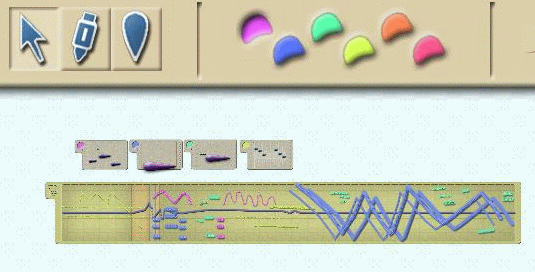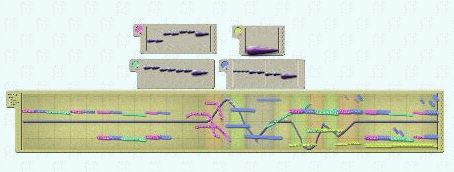Hyperscore
| Kwaliteit (1-5) | ***** |
| on (alleen online)/off (offline) | off |
| Interactive element (klein; redelijk; groot) | groot |
| Prijs (g=gratis; dg=demoversie gratis; sg=schoolversie gratis) | $30 |
| Leeftijd | vanaf 8 |
http://www.media.mit.edu/hyperins/ToySymphony/musictoysscore.html
www.hyperscore.com (downloadpagina)
Helaas niet meer gratis te downloaden. Kost inmiddels $30. Windows 98 se, ME, XP. Directx 8 of hoger, minimaal SVGA met geheugen.
Achtergrond:
With Toy Symphony, Tod Machover and his team at the MIT Media Lab strive to bridge the gap between professional musicians and children, as well as between audience and performers. This three year project, combining children, virtuosic performers like violinist Joshua Bell and conductor Kent Nagano, composers and symphony orchestras around the world, is intended to radically alter how children are introduced to music, serving to redefine the relationship between professional musicians and young people.
Through the use of innovative technologies to create musical instruments and compositional tools designed for an individual of any skill level, as well as weeklong workshops culminating in an integrated performance with children and professional musicians, Toy Symphony is designed as an utterly inclusive experience, one that will infuse the orchestra with youthful and enthusiastic collaborators, and the instruments, sounds, and ideas of the 21st century.
Toy Symphony is an international music performance and education project led by composer and inventor Tod Machover at the MIT Media Lab and Media Lab Europe. It strives primarily to introduce children to the creative music-making process in bold, new ways. Building on visionary technologies developed for Machover's groundbreaking Brain Opera, specially designed Music Toys enable children to immediately engage in sophisticated listening, performing and composing-activities normally accessible only after years of study. The participation of major symphony orchestras, conductors and soloists enables children to play alongside some of the world's most accomplished musicians, and to learn by doing.
An integrated approach to music education and creativity is at the core of Toy Symphony. Through coherent musical concepts that are fused with intensive hands-on workshops, online activities for home or classroom, the exploration of new technological inventions, and a culminating public concert, Toy Symphony serves to show children that they can create their own music, discover the potential of the symphony orchestra, absorb musical and technological principles through Music Toys, and ultimately be an important part of a large-scale, professional production.
The workshop element is the means to this end. The working model for the Toy Symphony project is a week-long endeavor, in which the MIT Media Lab and Media Lab Europe teams are in residence with a particular performing arts organization. The launch event for each location where Toy Symphony will be performed is a festive Open House to introduce the general public to Music Toys, new technologies and the core music of the project. During the week, a series of workshops are held, introducing a number of children to musical expression and composition using Music Toys, and allowing about 40 children to prepare to participate in the final concert.
The culminating concert will highlight and promote the exciting new music created for and by children. These performances will include a full orchestra of professional musicians playing traditional instruments with electronic enhancements, local children using Music Toys, world-class conductors, and a celebrated hyper-soloist. It is a chance for all involved to engage in music making that bridges past and present, using futuristic technology, innovative pedagogy, and inspiring music to step firmly into the 21st century.
The Music Toys developed by Tod Machover and his team at the MIT Media Lab for Toy Symphony are very sophisticated instruments designed simply to be played by any person with the desire to make music, with the specific needs and capabilities of young people in mind. There is no skill prerequisite-only the willingness to participate. There are three principal instruments used in the work for general audiences, and a fourth instrument for a more sophisticated musician. Through the use of Music Toys, children and adults alike can shape and modify musical lines with expressive gesture and delicate touch (Beatbugs, Shapers); use special software to draw lines that turn into musical compositions (HyperScore); and also learn about the Hyperviolin, the latest in a series of enhanced expert performance instruments devised by the team. Each toy has a very specific musical and pedagogical function.
The Hyperviolin is the latest in a series of enhanced expert-performance hyperinstruments devised by Machover and the MIT Media Lab team. Driven by multi-channel, audio analysis and synthesis software and wireless hardware technology embedded in an enhanced violin bow, the Hyperviolin performance system gives extra power and finesse to a virtuoso player. Measurements of perceptual timbre qualities as well as musical gestures allow for the control of rich and varied soundscapes, and also allow music to be exchanged and modified between hyperviolinist and kids. Celebrated violinist Joshua Bell will play the Hyperviolin throughout the Toy Symphony tour.
HyperScore is the principal composition tool of the Toy Symphony project and is at the core of all pedagogical and creative activities. Designed to introduce children to musical composition and creativity in an intuitive and dynamic way, the "narrative" of a piece is expressed through freehand drawing: a linear gesture that is analyzed to derive its characteristic "feel." The child then creates or selects individual musical materials, in the form of chords, melodic motives, timbres or sounds-each color coded-which are then annotated along the spine of the narrative line. Finally, the HyperScore system automatically realizes a full composition integrating the specific musical material into the overall formal shape represented by the narrative line. Graphical building blocks, motives and completed works can be exchanged online in a version of the program that will soon be available for children and educators worldwide to download.
Hyperscore is een erg leuk compositieprogramma!
Basis: ontwerp maximaal 6 motieven. Teken met deze motieven een partituur. Afhankelijk van de lengte en de hoogte van de lijntjes worden de motieven x-maal herhaald en verandert de toonhoogte. Je kunt patronen kopieren, verslepen enz. Verder kun je de sterkte van elk getekend motief instellen en de klankleur strings of pizzicato laten zijn. prachtig speelgoed om op relatief eenvoudige manier complexe, maar toch overzichtelijke structuren te maken.
In de 2 screendumps zie je 2 totaal verschillende composities.

In bovenstaand voorbeeld 4 motieven. let op de stevige akkoorden in blauw na de eerste zachte "gele" motieven. Op het einde in blauw een driedubbele canon, met daar doorheen verweven harde en zachte "groene" motieven.

In dit laatste voorbeeld altijd is kortjakje ziek, gebaseerd op 4 motieven. Eerst letterlijk, dan in octaven pizzicato + arco, dan wordt er wat met de motieven gespeeld, op einde in canon met orgelpunt (geel) en flarden motieven " 'zondags ga je naar de kerk" in blauw. Verder kun je alles "tonaler" maken door soort akkoorden te kiezen (knopjes links van tekenveld) en een centrale lijn zodanig te verslepen dat bepaalde motieven in bepaalde akkoordgebieden zitten (zie de kleurvelden bij bovenstaande compositie).